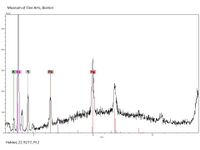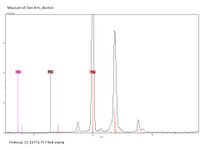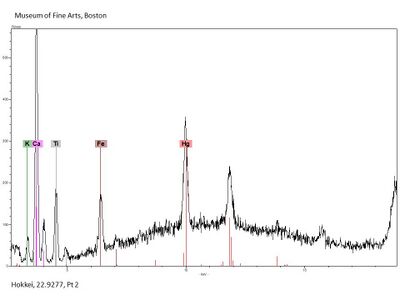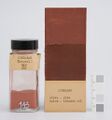Difference between revisions of "Category:Vermilion: Ukiyo-e colorant"
| (10 intermediate revisions by 2 users not shown) | |||
| Line 4: | Line 4: | ||
<font size="3">'''[[Vermilion]]'''</font> 朱 (''shu''): A bright red pigment composed of synthetically prepared red mercuric sulfide. Vermilion is chemically identical to the mineral [[Cinnabar|cinnabar]] (辰砂 ''shinsha''). | <font size="3">'''[[Vermilion]]'''</font> 朱 (''shu''): A bright red pigment composed of synthetically prepared red mercuric sulfide. Vermilion is chemically identical to the mineral [[Cinnabar|cinnabar]] (辰砂 ''shinsha''). | ||
| − | Vermilion appears to have been rarely used as a colorant in ''ukiyo-e'' prints. In the mid-1800s it seems to have been mixed with [[:Category:Madder: Ukiyo-e colorant|madder]] to create a | + | Vermilion appears to have been rarely used as a colorant in ''ukiyo-e'' prints. In the mid-1800s it seems to have been mixed with [[:Category:Madder: Ukiyo-e colorant|madder]] to create a darker red color mostly seen used on cartouches. Although not part of the printing matrix, vermilion is also found in collector's seals often found on ''surimono'' prints (摺物). Vermilion is the commonly used red ink for seals. |
'''For additional information see:''' [[Vermilion]] | '''For additional information see:''' [[Vermilion]] | ||
| Line 16: | Line 16: | ||
|- | |- | ||
| | | | ||
| − | [[File: | + | [[File:219277-Pt2-XRF.jpg|200px]]<br>[[Hokkei, Goat Standing by a Plum Tree, 21.9277|Pt 2: Printed<br>Totoya Hokkei, 21.9277]] |
|} | |} | ||
| Line 23: | Line 23: | ||
|- | |- | ||
| | | | ||
| − | [[File: | + | [[File:1116773-Pt7-XRF.jpg|200px]]<br>[[Hokusai, Woman Buying Songbirds, from the series A Collection of Dances, 11.16773|Pt 7: Vermilion<br>Katsushika Hokusai, 11.16773]] |
|} | |} | ||
| Line 50: | Line 50: | ||
X-ray fluorescence analysis (XRF) is used to detect mercury (Hg). When found in a red area, it is an indication for the presence of vermilion (HgS). | X-ray fluorescence analysis (XRF) is used to detect mercury (Hg). When found in a red area, it is an indication for the presence of vermilion (HgS). | ||
<gallery mode="packed" heights="200px" style="text-align:left;"> | <gallery mode="packed" heights="200px" style="text-align:left;"> | ||
| − | + | 219277-Pt2-XRF.jpg|<center>XRF spectrum for Vermilion</center> | |
</gallery> | </gallery> | ||
Latest revision as of 23:47, 17 August 2024
Vermilion 朱 (shu): A bright red pigment composed of synthetically prepared red mercuric sulfide. Vermilion is chemically identical to the mineral Cinnabar (辰砂 shinsha).
Vermilion appears to have been rarely used as a colorant in ukiyo-e prints. In the mid-1800s it seems to have been mixed with madder to create a darker red color mostly seen used on cartouches. Although not part of the printing matrix, vermilion is also found in collector's seals often found on surimono prints (摺物). Vermilion is the commonly used red ink for seals.
For additional information see: Vermilion
Examples of Vermilion in Ukiyo-e Prints
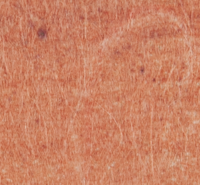
|

|

|

|

|
Analysis
X-ray fluorescence analysis (XRF) is used to detect mercury (Hg). When found in a red area, it is an indication for the presence of vermilion (HgS).
Images of Vermilion
List of Prints
Below is a list of prints where vermilion was detected.
Pages in category "Vermilion: Ukiyo-e colorant"
The following 5 pages are in this category, out of 5 total.

